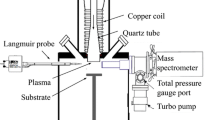Abstract
Plasma polymerization of trimethylsilane (TMS) was carried out and investigated in a direct current (dc) glow discharge. The formation of TMS plasma glow was carefully examined with optical photography as compared with an Ar dc glow discharge. It was found that there exists a significant difference in the nature of glow and how the glow is created in TMS glow discharge, which polymerizes or causes deposition, and that of monatomic gas such as Ar, which does not polymerize or deposit. In dc Ar discharge, the negative glow, which is the most luminous zone in the discharge, develops in a distinctive distance away from the cathode surface, and the cathode remains in the dark space. In a strong contrast to this situation, in TMS dc discharge, the primary glow that is termed as cathode-glow in this paper appears at cathode surface, while a much weaker negative glow as a secondary glow was observed at the similar location to where the Ar negative glow appears. The deposition results of plasma polymers and gas phase composition data of TMS in a closed reactor acquired by ellipsometry and residual gas analyzer (RGA) measurements clearly indicated that the cathode-glow in TMS glow discharge is mainly associated with chemically reactive species that would polymerize or form deposition, but the negative glow is related to species from simple gases that would not polymerize or deposit. Based on the glow location with respect to the cathode, it was deduced that the cathode-glow is due to photon emitting species created by molecular dissociation of the monomer that is caused by low energy electrons emanating from the cathode surface. The negative glow is due to the ionization and the formation of excited neutrals of fragmented atoms caused by high-energy electrons. Polymerizable species that would cause deposition of material (plasma polymers) are created mainly by the fragmentation of monomer molecules by low energy electrons, but not by electron-impact ionization of the monomer.
Similar content being viewed by others
REFERENCES
G. Francis, The glow discharge at low pressure, in Handbuch der Physik, 22 S. Flügge, Springer, Berlin, Germany, 1956, 53-208.
A. M. Howatson, An Introduction to Gas Discharges, 2nd ed., Pergamon Press, New York, 1976.
H. K. Yasuda and Q. S. Yu, J. Vac. Sci. Technol., A19(3), 773-781 (2001).
Qingsong Yu, C. E. Moffitt, D. M. Wieliczka, and H. Yasuda, J. Vac. Sci. Technol. A19(5), 2163-2167 (2001).
H. Yasuda, Plasma Polymerization, Academic Press, San Diego, CA, 1985.
J. G. Zhao and H. K. Yasuda, J. Vacuum Sci. Technol. 18(5), 2062-2066 (2000).
W. H. Tao and Hirotsugu K. Yasuda, Plasma Chem. Plasma Process. 22(2), 313(2002).
B. Chapman, Glow Discharge Processes, Wiley, New York, 1980.
Q. S. Yu and H. K. Yasuda, J. Polym. Sci. Polym. Chem. Ed. 37, 967-982 (1999).
Qingsong Yu, C. E. Moffitt, D. M. Wieliczka, J. Deffeyes, and H. Yasuda, Prog. Org. Coat. 44, 37(2002).
H. K. Yasuda, Q. S. Yu, C. M. Reddy, C. E. Moffitt, and D. M. Wieliczka, J. Appl. Polym. Sci. 85(7), 1387(2002).
H. K. Yasuda, Q. S. Yu, C. M. Reddy, C. E. Moffitt, and D. M. Wieliczka, J. Appl. Polym. Sci. 85(7), 1443(2002).
F. F. Oldfield, D. L. Cowan, and H. K. Yasuda, Plasmas Polym. 5(3/4), 235-253 (2000).
F. F. Oldfield, D. L. Cowan, and H. K. Yasuda, Plasmas Polym. 6, 51-69 (2001).
H. Kobayashi, M. Shen, and A. T. Bell, J. Macromol. Sci. Chem. A8, 1354(1974).
Q. S. Yu and H. K. Yasuda, J. Polym. Sci.: Part A: Polym. Chem. 36, 1583(1998).
M. M. Millard and E. Kay, J. Electrochem. Soc. 129, 161(1982).
S. P. Fusselman and H. K. Yasuda, Plasma Chem. Plasma Process. 14, 251(1994).
Q. S. Yu and H. K. Yasuda, Plasma Chem. Plasma Process. 18, 461(1998).
F. Cramarossa, S. De Benedictis, and G. Ferraro, J. Quant. Spectrosc. Radiat. Trans. 23, 291(1980).
R. D'Agostino, F. Cramarossa, S. De Benedictis, and G. Ferraro, Plasma Chem. Plasma Process 1, 19(1981).
A. Pastol and Y. Catherine, J. Phys. D 23, 799(1990).
J. W. Coburn and M. Chen, J. Appl. Phys. 51, 3134(1980).
T. Yasuda, T. Okuno, M. Miyama, and H. Yasuda, J. Polym. Sci.: Part A: Polym. Chem. 32, 1829(1994).
E. Krentsel, S. Fusselman, H. Yasuda, T. Yasuda, and M. Miyama, J. Polym. Sci.: Part A: Polym. Chem. 32, 1839(1994).
Author information
Authors and Affiliations
Rights and permissions
About this article
Cite this article
Yasuda, H., Yu, Q. Creation of Polymerizable Species in Plasma Polymerization. Plasma Chemistry and Plasma Processing 24, 325–351 (2004). https://doi.org/10.1023/B:PCPP.0000013204.17559.72
Issue Date:
DOI: https://doi.org/10.1023/B:PCPP.0000013204.17559.72




